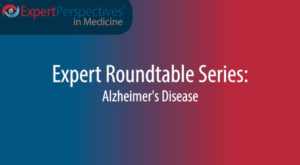Neurology
Alzheimer's Disease
Current and Emerging Diagnostics and Treatments in Alzheimer’s Disease
If a patient or reporter (eg, family member) has a cognitive concern, or if you notice something, follow up on it. Coming from a primary care background, I may be unable to follow up on a cognitive concern that same day because the patient is in the office for something else, such as shoulder pain, a sore throat, or high blood pressure, for example. Take care of those things first. Thereafter, do a cognitive screening test, which can be performed in reasonably short order and during a single visit.
In terms of what has changed, it is not so much our instruments, as we have had validated instruments built for primary care for some time. Rather, there is more of an increased need to apply them, to take that extra step of being a good sentinel. These instruments are easy to use and understand, and they can aid in finding out a fair amount of information about patients. We really do want to shift that screening sooner, checking on cognitive function annually at age 65 years and older so that we can potentially do so much more for the patient. Obtaining some background information on how the patient has been doing may also be informative, and this can be especially helpful if a reporter is also present.
Despite the availability of these approaches, diagnosing Alzheimer’s disease and differentiating it from other dementia-related illnesses can still be challenging. To this, I would recommend getting your specialist on board early; I always want a copilot. Order that initial magnetic resonance imaging scan, then refer the patient to the specialist to confirm the diagnosis and initiate treatment.
It is also important to consider getting help from organizations that have good support programs, such as the Alzheimer’s Association or even AARP. Social workers, case managers, senior centers, and other types of similar programs can also help to promote healthy living, even in cases of mild to moderate dementia.
I am really excited about the concept of biomarkers and using these tests to help confirm the biomedical diagnosis of Alzheimer’s disease. That is a very positive step forward. There have also been advances in terms of the management of agitation, starting with just continuing those symptomatic therapies, which can often be effective even into more severe dementia, and adding other pharmacotherapy when necessary.
My approach to diagnosing patients with Alzheimer’s disease has changed radically over the last few years. In the past, a diagnosis of Alzheimer’s disease was made primarily based on clinical symptoms (eg, forgetfulness, getting lost, and/or misplacing items such as your glasses or keys) and by excluding other pathologies. Only within the last few years (ie, since we started focusing on disease-specific and blood-based biomarkers) have we started to define Alzheimer’s disease not as a clinical disease but a biological disease. The 2016 A/T/N criteria defined Alzheimer’s disease using amyloid, tau, and neurodegeneration, and the 2024 Alzheimer’s Association Workgroup update added biomarkers such as vascular inflammation and synuclein as helpful criteria for the diagnosis and staging of Alzheimer’s disease.
In my practice, I use blood-based biomarkers, including amyloid, tau, phosphorylated tau 217 (p-tau217), p-tau181, amyloid-β 42/40 (Aβ42/40), and neurofilament light chain (NfL). If patients have abnormal measurements, I then perform secondary testing using cerebrospinal fluid or amyloid positron emission tomography (PET). We now go to a biological biomarker-driven diagnosis much faster than we did in the past to obtain an accurate diagnosis and to earlier identify patients who might be eligible for treatment, including disease-modifying therapy.
Disease-modifying therapy fundamentally alters the trajectory of Alzheimer’s disease by altering its pathology. These drugs are only US Food and Drug Administration (FDA) approved for patients with mild cognitive impairment or dementia to remove amyloid and slow the rate of cognitive decline. We should be selective about which patients receive these medications. For example, they cannot have a pacemaker because routine magnetic resonance imaging scans are required. They also cannot have many brain microhemorrhages since that will increase the risk for amyloid-related imaging abnormalities (ARIA). If patients are APOE e4 homozygote carriers, treatment with disease-modifying therapies may not be warranted due to an increased risk of developing ARIA.
Monoclonal antibodies are not the only new treatments for Alzheimer’s disease. We are seeing multiple investigational targets that are exciting. For example, there are now agents that target the sigma-1 receptor, inducing autophagy. I am also excited about the first reports showing that we can lower tau levels. That has been a tough nut to crack. These and other targets are being exploited by new investigational drugs that are gaining ground.
I think that we have covered the groundwork for how diagnosis can vary depending on where you see the patient and how much referral has already occurred before they get to you as a geriatrician, neurologist, or behavioral neurologist. I also believe that we are close to having a reliable blood-based biomarker that will probably be a combination of different tests that could be used before needing to obtain an amyloid PET scan, a tau PET scan, or a cerebrospinal fluid evaluation. Whether this biomarker combination will be used as a screening test in primary care or as an indicator to inform the need for a neurology referral and treatment with disease-modifying therapy are yet to be determined.
It is important to remember that patients with Alzheimer’s disease or the mild cognitive impairment of Alzheimer’s disease who may be candidates for disease-modifying therapy are the most common patients with Alzheimer’s disease. These patients may not have previously been seen by subspecialty neurologists. Monoclonal antibodies are generally safe, but they do have their risks, including infusion-site reactions and ARIA, as they target amyloid in the brain’s microvasculature. There is growing interest in this new approach, and I hope that it translates into a greater pursuit of a diagnosis, where we actually have more people running toward the disease rather than away from it.
Finally, several small-molecule drugs are also under investigation as treatments for Alzheimer’s disease that target different stages in the amyloid pathway or in other novel ways. These are desirable as oral therapies with some targets beyond amyloid and tau. There is a lot going on right now.
Doran SJ, Sawyer RP. Risk factors in developing amyloid related imaging abnormalities (ARIA) and clinical implications. Front Neurosci. 2024;18:1326784. doi:10.3389/fnins.2024.1326784
Hampel H, Hu Y, Cummings J, et al. Blood-based biomarkers for Alzheimer’s disease: current state and future use in a transformed global healthcare landscape. Neuron. 2023;111(18):2781-2799. doi:10.1016/j.neuron.2023.05.017
Hansson O, Blennow K, Zetterberg H, Dage J. Blood biomarkers for Alzheimer’s disease in clinical practice and trials. Nat Aging. 2023;3(5):506-519. doi:10.1038/s43587-023-00403-3
Jack CR Jr, Andrews JS, Beach TG, et al. Revised criteria for diagnosis and staging of Alzheimer’s disease: Alzheimer’s Association Workgroup. Alzheimers Dement. 2024;20(8):5143-5169. doi:10.1002/alz.13859
Jack CR Jr, Bennett DA, Blennow K, et al. A/T/N: an unbiased descriptive classification scheme for Alzheimer disease biomarkers. Neurology. 2016;87(5):539-547. doi:10.1212/WNL.0000000000002923
Liss JL, Seleri Assunção S, Cummings J, et al. Practical recommendations for timely, accurate diagnosis of symptomatic Alzheimer’s disease (MCI and dementia) in primary care: a review and synthesis. J Intern Med. 2021;290(2):310-334. doi:10.1111/joim.13244
Prasanth MI, Malar DS, Tencomnao T, Brimson JM. The emerging role of the sigma-1 receptor in autophagy: hand-in-hand targets for the treatment of Alzheimer’s. Expert Opin Ther Targets. 2021;25(5):401-414. doi:10.1080/14728222.2021.1939681
Shcherbinin S, Evans CD, Lu M, et al. Association of amyloid reduction after donanemab treatment with tau pathology and clinical outcomes: the TRAILBLAZER-ALZ randomized clinical trial. JAMA Neurol. 2022;79(10):1015-1024. doi:10.1001/jamaneurol.2022.2793
Singh H, Das A, Khan MM, Pourmotabbed T. New insights into the therapeutic approaches for the treatment of tauopathies. Neural Regen Res. 2024;19(5):1020-1026. doi:10.4103/1673-5374.385288
Turgutalp B, Kizil C. Multi-target drugs for Alzheimer’s disease. Trends Pharmacol Sci. 2024;45(7):628-638. doi:10.1016/j.tips.2024.05.005













